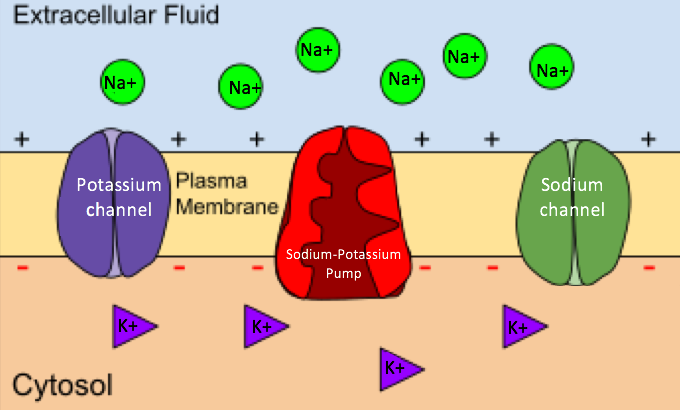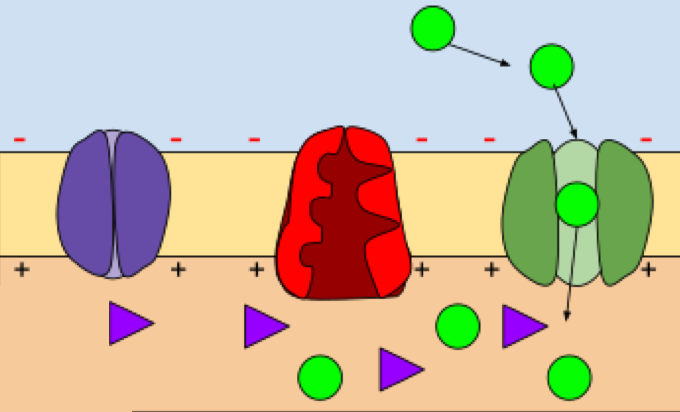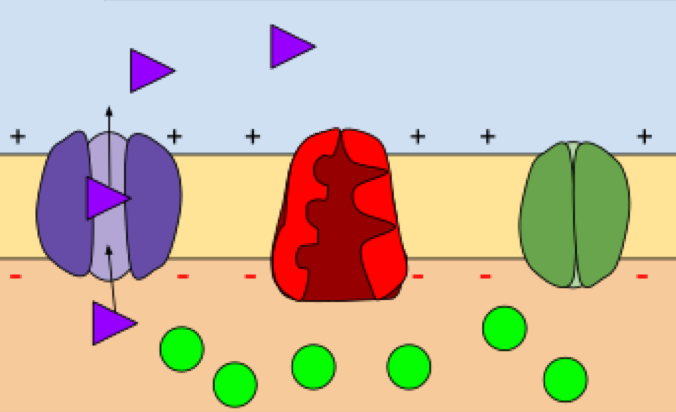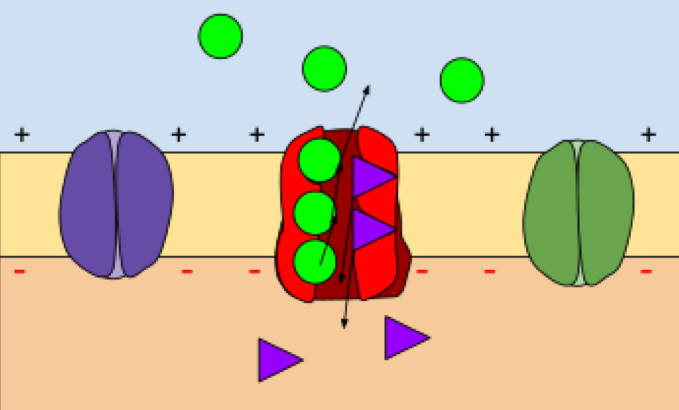Table of Contents |
Sodium and potassium are the two ions that are very important for setting the stage for a nerve impulse. Recall from the Unit I lesson on Facilitated Diffusion that sodium-potassium pumps are proteins embedded in the plasma membrane. With the help of ATP, these pumps move sodium (Na+) from an area of low concentration within the cell to an area of high concentration outside the cell. At the same time, these pumps move potassium (K+) from an area of low concentration outside the cell to an area of high concentration inside the cell. This creates a chemical gradient, but it also creates an electrical gradient (a "voltage potential"). Cells have a resting membrane potential that is slightly negatively charged compared to the environment outside the cell.
If both sodium (Na+) and potassium (K+) have the same positive charge, how does forcing them to swap places across the cell membrane make a cell negatively charged? For every three sodium ions pumped out of the cell, two potassium ions are pumped in:
An action potential is basically just another way of saying a nerve impulse. An action potential occurs when a stimulus causes the voltage difference across a cell membrane to shift. Sometimes the voltage difference will shift at random, but this will not cause neurons to fire randomly (as is the case with epilepsy). To relay only true signals, a neuron's stimulation has to be so strong that the voltage changes about a threshold—a minimum shift needed for that action potential to occur. Once it occurs, the signal travels very fast along the neuron.
For this action potential to occur, the voltage difference across a cell membrane has to shift by a certain amount (above the threshold). Once it's shifted by that amount, an action potential can happen.
Here are the steps that occur in an action potential.
To better understand what happens in action potential, take a look at the diagrams below.

As mentioned, the outside of the neuron is generally positive relative to the inside. You have your cell membrane and then embedded within that, you have something called a sodium-potassium pump. Then you have your gated sodium channels. Typically, these gated sodium channels are closed, making the cell membrane more or less impermeable to sodium. Sodium is not allowed to flow through freely.

When stimulation causes an action potential, sodium gates will open, allowing sodium to flow into the cell. As that happens, more and more of these gates will open, allowing more and more sodium to flow in. This will continue to happen until the threshold is reached and the voltage difference is reversed.

Now, this isn't all happening throughout the whole membrane at the same time; it occurs in patches of the membrane. As sodium moves into the cell in one patch, the previous patch of that membrane will allow potassium to leak out. This reverses the voltage difference across the cell membrane and will cause the impulse to propagate along that cell membrane in patches. You can think of an action potential moving down the axon the way a ring might slide down your finger.

Eventually, the resting membrane potential has to be restored. That's where the sodium-potassium pumps (in red) come into play. The sodium-potassium pumps will restore that resting membrane potential. In order to perform this, it has to use the cell's ATP, which is a form of active transport because it's using ATP to restore this membrane potential. What the sodium-potassium pump will do is put sodium back out and potassium back in. As that action potential was happening, you had your sodium diffusing in and potassium diffusing out, which was reversing our voltage difference across the membrane. However, in order to restore that resting membrane potential, you have to get the sodium back out and the potassium back in. Only then our resting membrane potential can be restored.
Once the action potential has reached the output zone, the signal will be sent across the synapse (the tiny gap between the axon endings and another cell), usually via a neurotransmitter to the next cell that needs to receive the signal (another neuron, a muscle fiber or a gland cell).
Source: THIS WORK IS ADAPTED FROM SOPHIA AUTHOR AMANDA SODERLIND